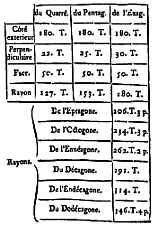 Also
called a Fortified Polygon. A polygon (multi-sided closed figure) drawn around
an area to be protected by a fortification. A fortified polygon may be regular,
with all sides and all angles equal, or irregular, with the lengths of the
sides and angles unequal. Each side of a fortified polygon, called the exterior
side of the polygon, defined the fronts of fortification and could be fortified
according to any appropriate system of fortification such as the bastion,
polygonal, circular, or tenaille system. Also
called a Fortified Polygon. A polygon (multi-sided closed figure) drawn around
an area to be protected by a fortification. A fortified polygon may be regular,
with all sides and all angles equal, or irregular, with the lengths of the
sides and angles unequal. Each side of a fortified polygon, called the exterior
side of the polygon, defined the fronts of fortification and could be fortified
according to any appropriate system of fortification such as the bastion,
polygonal, circular, or tenaille system.
The lengths of the exterior sides of a fortified polygon were limited by
the range of the weapons taken as the primary means of close and collateral
defense since the length of the lines of defense depended on the lengths
of the exterior sides. Small arms fire was taken as the primary means of
defense in the bastion system which limited the exterior sides of a fortified
polygon to between 300 and 400 yards. The polygonal system relied on
 artillery
as the primary means of collateral defense which allowed an increase in the
length of the exterior sides of the fortified polygon. The introduction of
rifled small arms also allowed an increase in the length of the sides of
fortified polygons. artillery
as the primary means of collateral defense which allowed an increase in the
length of the exterior sides of the fortified polygon. The introduction of
rifled small arms also allowed an increase in the length of the sides of
fortified polygons.
 In the bastion system the number of sides of a regular polygon
determined the length of the perpendicular (the interior line bisecting the
front of fortification which determined the orientation and angles of the
lines of defense). The perpendicular of a square was taken as 1/8th the length
of the exterior side, a pentagon as 1/7th the exterior side, and polygons
with 6 or more sides the perpendicular was taken as 1/6th the exterior side.
An exterior side that was too short would not contain sufficient space to
fully develop the flanks and faces of bastions for an effective defense,
while a side that was too long would prevent the flanked angles of bastions
from being fully covered by fire from collateral flanks or compel the inclusion
of a flat bastion at the mid-point of the exterior side which would greatly
increase the cost in time, labor, and materials to construct the fortification. In the bastion system the number of sides of a regular polygon
determined the length of the perpendicular (the interior line bisecting the
front of fortification which determined the orientation and angles of the
lines of defense). The perpendicular of a square was taken as 1/8th the length
of the exterior side, a pentagon as 1/7th the exterior side, and polygons
with 6 or more sides the perpendicular was taken as 1/6th the exterior side.
An exterior side that was too short would not contain sufficient space to
fully develop the flanks and faces of bastions for an effective defense,
while a side that was too long would prevent the flanked angles of bastions
from being fully covered by fire from collateral flanks or compel the inclusion
of a flat bastion at the mid-point of the exterior side which would greatly
increase the cost in time, labor, and materials to construct the fortification.
Lengths of bastion faces were also determined by the length of the exterior
side of the fortified polygon. In Vauban's First System (and most subsequent
methods of fortifying a front according to the bastion system) the length
of bastion faces was taken as being equal to 2/7ths the length of the exterior
side. |